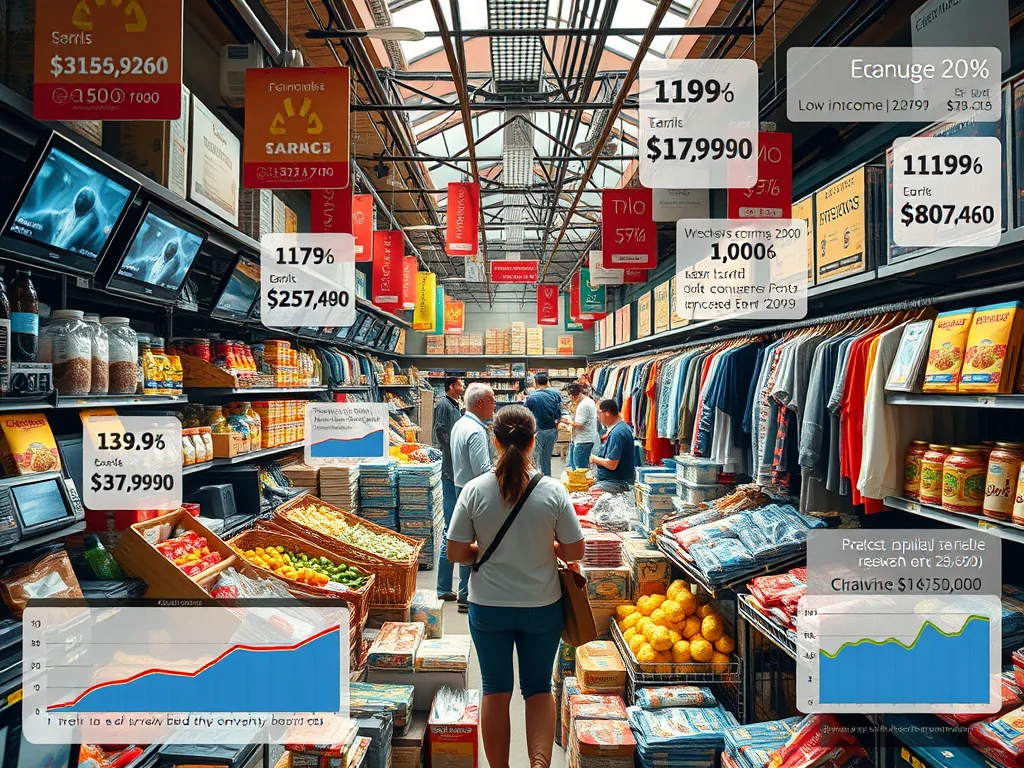Table of Contents
Introduction
The announcement of tariffs by U.S. President Donald Trump has sparked widespread debate about their economic and geopolitical ramifications. These tariffs, aimed at addressing issues such as illegal immigration, drug trafficking, and trade imbalances, target imports from key trading partners, including Mexico, Canada, and China. While the stated goals are to protect domestic industries and assert U.S. interests, the broader consequences of such measures extend across domestic and international landscapes, influencing consumer behavior, industry dynamics, and global trade relationships.
Impact on American Consumers
Tariffs function as a tax on imported goods, and the burden of this cost is often passed on to consumers. This can lead to immediate price increases for a wide array of products, from electronics and automobiles to household goods and clothing. For American consumers, the effects of these tariffs will likely be felt in both their wallets and their spending habits.
Price Increases Across Consumer Goods
The imposition of tariffs directly raises the cost of importing goods. Products such as smartphones, laptops, and televisions, many of which are assembled or sourced from China, are expected to see significant price hikes. Similarly, automobiles—a sector deeply intertwined with Mexican and Canadian supply chains—may become more expensive as manufacturers face higher costs for imported parts and components.
In the retail sector, the increased cost of imported clothing and household goods will affect consumers’ everyday purchases. Families with tight budgets may need to make difficult choices, prioritizing essential items over discretionary spending. This shift could have ripple effects across the broader economy, as retail and service industries experience declining sales.
Effects on Discretionary Spending
As prices rise, American consumers may reduce spending on non-essential goods and services. Dining out, travel, entertainment, and luxury items are likely to see diminished demand. Industries reliant on discretionary spending, such as hospitality and entertainment, could face declining revenues, potentially leading to job losses and reduced economic activity.
Disproportionate Impact on Low-Income Households
Tariffs disproportionately affect lower-income households, which spend a larger percentage of their income on goods and services. These households are less equipped to absorb price increases and may face greater financial strain as they adjust their spending. For families already struggling to make ends meet, higher costs for essentials such as food, clothing, and household items could exacerbate economic inequality.
Impact on Industries and Employment
The ripple effects of tariffs extend beyond consumers to industries and employment. Many U.S. businesses rely on global supply chains, importing raw materials and components for manufacturing. The increased costs associated with tariffs can disrupt operations and reduce profitability.
Manufacturing and Supply Chain Disruptions
Manufacturers that depend on imported materials face significant challenges when tariffs raise input costs. For instance, the automotive industry—which relies on parts from Mexico and Canada—may see production costs rise, forcing companies to increase prices or absorb the losses. This could lead to reduced demand, layoffs, and even plant closures.
In addition to manufacturing, sectors like construction and technology that rely on imported machinery and components may also face higher costs. Small businesses, in particular, may struggle to adapt, as they often lack the resources to redesign supply chains or negotiate better terms with suppliers.
Agricultural Sector Challenges
The agricultural industry, heavily reliant on exports, is especially vulnerable to retaliatory tariffs. Countries like China, Mexico, and Canada are significant markets for American agricultural products, including soybeans, corn, and meat. Retaliatory measures could reduce demand for these goods, driving down prices and hurting farmers’ livelihoods.
Farmers who depend on international markets may face difficult decisions, such as scaling back production or seeking alternative markets. The financial strain on rural communities could have far-reaching social and economic consequences, including increased farm bankruptcies and declining support for political policies perceived as harmful to agriculture.
Impact on Small and Medium Enterprises
Small and medium-sized enterprises (SMEs) are particularly vulnerable to the effects of tariffs. These businesses often have limited flexibility to absorb increased costs or shift to alternative suppliers. For SMEs in industries such as retail, manufacturing, and agriculture, tariffs can threaten profitability and long-term viability. Job losses and business closures may follow, compounding the economic impact.
Impact on Consumers in Targeted Countries
While American consumers bear the brunt of higher prices domestically, consumers in countries targeted by tariffs may also face significant consequences. Retaliatory tariffs and disruptions to trade relationships can create economic challenges for these countries.
Price Increases and Supply Chain Adjustments
In countries like Mexico, Canada, and China, retaliatory tariffs on U.S. goods could lead to increased prices for imported American products. For example, Mexican consumers may see higher costs for agricultural products such as corn and soybeans, while Canadian consumers might face price hikes for goods that rely on American components.
Economic Consequences for Export-Dependent Industries
Industries in targeted countries that rely on exports to the U.S. may experience disruptions due to reduced demand. For example, Chinese manufacturers that produce goods for the American market may see declining orders, leading to job losses and reduced production. Similarly, Canadian and Mexican industries integrated into U.S.-based supply chains could face challenges in maintaining operations and profitability.
Regional Economic Adjustments
Targeted countries may respond to tariffs by diversifying their trade relationships and reducing dependence on the U.S. market. This could involve seeking new export markets, investing in domestic industries, or forming alliances with other countries. While these strategies may create long-term opportunities, the short-term economic impacts could be disruptive for businesses and consumers alike.
Implications for International Trade Relationships
The use of tariffs as a tool for addressing non-trade issues, such as immigration and drug trafficking, represents a significant shift in trade policy. This approach has the potential to strain diplomatic relationships and reshape international trade dynamics.
Strained Diplomatic Relations
Tariffs targeting allies such as Mexico and Canada can create diplomatic tensions, particularly if they are perceived as punitive or unilateral. These tensions may complicate cooperation on other critical issues, such as border security, energy policy, and environmental agreements.
Erosion of Trust in Trade Agreements
Trade agreements like the United States-Mexico-Canada Agreement (USMCA) are built on principles of mutual benefit and trust. The imposition of tariffs outside the framework of these agreements could erode confidence in their stability and effectiveness. This may lead to a reevaluation of the terms and commitments by all parties involved, potentially weakening the agreement’s long-term viability.
Encouragement of New Alliances
Countries affected by U.S. tariffs may seek to strengthen economic ties with other nations to reduce reliance on the American market. For example, China could accelerate efforts to expand its Belt and Road Initiative, while Canada and Mexico might deepen trade relationships with Europe or Asia. These developments could shift the balance of global trade and diminish U.S. influence in key markets.
Long-Term Economic and Political Implications
The long-term consequences of tariffs extend beyond immediate economic impacts, influencing the global perception of the United States as a trade partner and economic leader.
Diversification of Supply Chains
Businesses worldwide may seek to diversify their supply chains to mitigate the risks associated with U.S. tariffs. This trend could reduce dependence on American markets and foster the growth of alternative trade hubs. Southeast Asian countries, for example, may become more attractive manufacturing destinations, further reshaping global supply chains.
Challenges for Multilateral Trade Organizations
The increased use of unilateral tariffs could undermine the role of multilateral trade organizations, such as the World Trade Organization (WTO). These organizations play a critical role in resolving trade disputes and promoting fair trade practices. If countries increasingly bypass these frameworks, the global trade system may become more fragmented and conflict-prone.
Political Ramifications
Domestically, the tariffs could become a divisive political issue. Supporters may argue that they protect American jobs and industries, while critics contend that they harm consumers and strain international relationships. The economic consequences of tariffs may influence voter perceptions and shape the political landscape in upcoming elections.
Alternatives to Tariffs
While tariffs are a common tool for addressing trade imbalances and policy concerns, alternative strategies may offer more sustainable and effective solutions.
Diplomatic Negotiations
Engaging in diplomatic negotiations and fostering international cooperation can address issues such as immigration and drug trafficking without resorting to economic measures that harm consumers and businesses. Collaborative efforts can lead to more balanced and mutually beneficial outcomes.
Investments in Domestic Industries
Investing in domestic industries and workforce development could reduce reliance on imports and enhance the competitiveness of American businesses. Initiatives such as infrastructure development, education, and technological innovation can create new opportunities for economic growth.
Strengthening Multilateral Frameworks
Reinforcing the role of multilateral trade organizations and agreements can help address trade disputes and promote stability in the global economy. By working within these frameworks, countries can resolve conflicts more effectively and maintain confidence in the international trade system.
Summary
The use of tariffs as a policy tool highlights the complex interplay between trade, domestic economic priorities, and international relationships. While the tariffs aim to address specific policy concerns, their implementation carries significant risks, including higher prices for consumers, disrupted industries, strained trade relationships, and long-term shifts in global economic dynamics. As countries navigate these challenges, thoughtful and collaborative approaches to trade policy will be essential to ensuring economic stability and fostering mutual prosperity.

